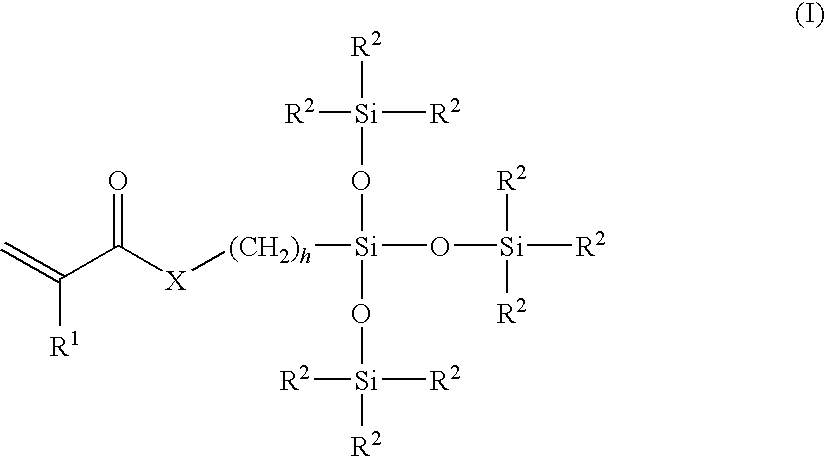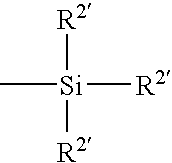Brush copolymers
a technology of copolymer and brush, applied in the field of brush copolymer, can solve the problems of eye discomfort or even inflammation, surface of the lens affecting the susceptibility of the lens to deposition, and the process is disclosed, so as to prevent or limit the adsorption of tear lipids, improve the performance quality and/or comfort, and preserve the clarity of the contact lens
- Summary
- Abstract
- Description
- Claims
- Application Information
AI Technical Summary
Benefits of technology
Problems solved by technology
Method used
Image
Examples
example 1
Preparation of Methacrylated DMA / SBA Macromer
[0105]To a 1-L 3-neck round bottom flask containing a magnetic stir bar, water-cooled condenser and thermocouple was added 0.138 g AIBN (0.35-wt % based on total weight of DMA), 3.32 g (10-mol % based on DMA and SBA, Aldrich Cat. No. M2650) of 2-mercaptoethanol, 3.14 g (5-mol % based on DMA, Aldrich Cat. No. 417580) of SBA and 40.0 g of distilled DMA (Aldrich Cat. No. 274135). The mixture was dissolved by the addition of 300 mL of anhydrous acetonitrile to the flask. The solution was sparged with argon for at least 10 minutes before gradual heating to 60° C. The sparging was discontinued when the solution reached 40 to 45° C. and the flask was subsequently maintained under argon backpressure. After 72 hours heating was discontinued at which point the room temperature solution was added dropwise to 6 L of stirred ethyl ether. The ether was decanted off and the resulting solid was dried in vacuo at 85° C. overnight affording 35.1 g of hydro...
example 2
Preparation of DMA / SBA Brush Polymer
[0107]To a 300-mL 3-neck round bottom flask containing a magnetic stir bar, water-cooled condenser and thermocouple was added 0.093 g AIBN (1.0-wt % based on total weight of monomers), 0.29 g (4.5-mol %, Aldrich Cat. No. 417580) of SBA, 5.0 g of the methacrylated DMA / SBA macromer of Example 1 (10 mol %), 0.67-g (9.0-mol %, Aldrich Cat. No. 409472-1 L) of deinhibited and distilled DMAPMA and 3.30-g (76.5-mol %, Aldrich Cat. No. 274135-500 mL) of distilled DMA. The monomers and initiator were dissolved by addition of 100 mL of methanol to the flask. The solution was sparged with argon for at least 10 minutes before gradual heating to 60° C. The sparging was discontinued when the solution reached 40 to 45° C. and the flask was subsequently maintained under argon backpressure. After 72 hours heating was discontinued, at which point the cooled solution was added drop wise to 6 L of mechanically stirred ethyl ether. The precipitate was isolated by vacuu...
example 3
[0108]Contact lenses made of Balafilcon A were cast and processed under standard manufacturing procedures. Balafilcon A is a copolymer comprised of 3-[tris(tri-methylsiloxy)silyl]propyl vinyl carbamate, N-vinyl-2-pyrrolidone (NVP), 1,3-bis[4-vinyloxycarbonyloxy)but-1-yl]polydimethylsiloxane and N-vinyloxycarbonyl alanine. All Balafilcon A lenses were air-plasma treated prior to exposure to the brush copolymer coating of Example 2.
[0109]For coating with the subject brush copolymer, each lens was placed in a polypropylene blister containing 3.8-mL of a 500 ppm (w / v) solution of the subject polymer dissolved in borate-buffered saline (BBS) containing 300 ppm EDTA. The blisters were sealed and autoclaved at 121° C. for 30 minutes. Examination of thoroughly rinsed coated lenses were examined by X-ray photoelectron spectroscopy (XPS) and compared to uncoated controls lenses. The XPS results for the lenses are set forth below in Table 1.
[0110]
TABLE 1Sample% C% N% O% SiControl64.7 ± 0.37.4 ...
PUM
| Property | Measurement | Unit |
|---|---|---|
| osmolality | aaaaa | aaaaa |
| weight percent | aaaaa | aaaaa |
| temperature | aaaaa | aaaaa |
Abstract
Description
Claims
Application Information
 Login to View More
Login to View More - R&D
- Intellectual Property
- Life Sciences
- Materials
- Tech Scout
- Unparalleled Data Quality
- Higher Quality Content
- 60% Fewer Hallucinations
Browse by: Latest US Patents, China's latest patents, Technical Efficacy Thesaurus, Application Domain, Technology Topic, Popular Technical Reports.
© 2025 PatSnap. All rights reserved.Legal|Privacy policy|Modern Slavery Act Transparency Statement|Sitemap|About US| Contact US: help@patsnap.com



